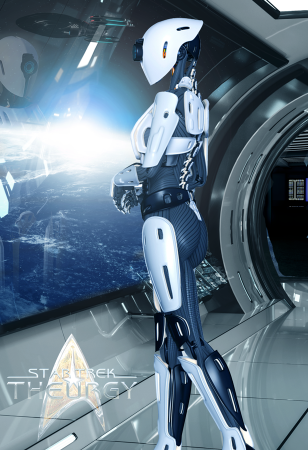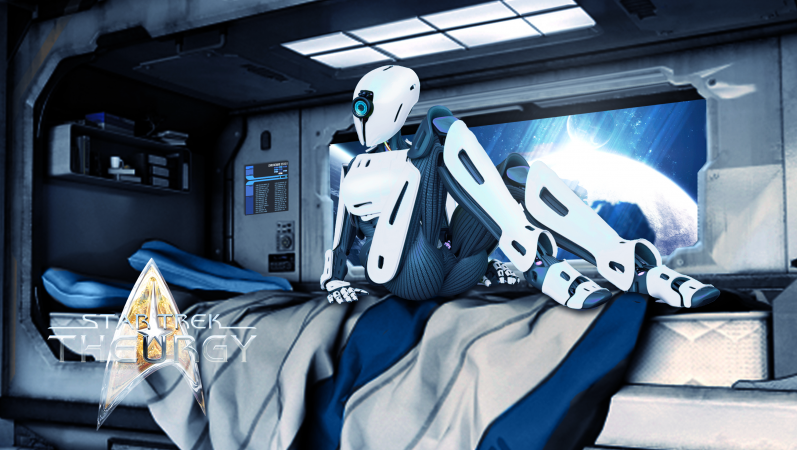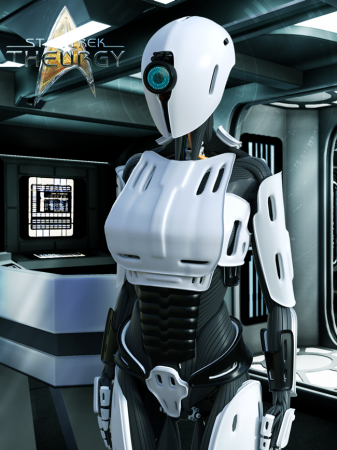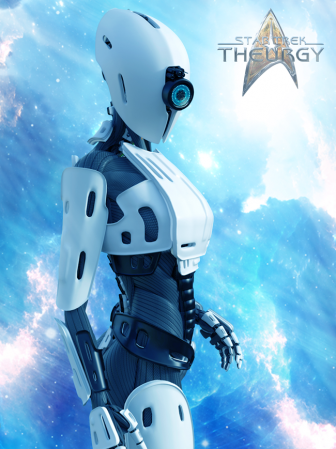V-Nine
From Star Trek: Theurgy Wiki
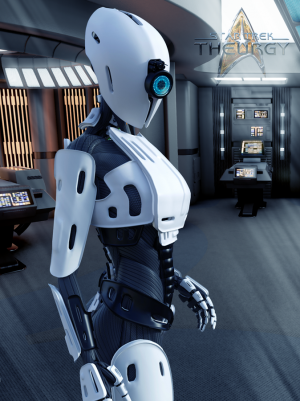 | |||
| |||
|---|---|---|---|
| Name: | Vigenary Model I-9 Surgical Android Abbreviated to V-Nine Nicknamed Vi (pron. "vye/vee") | ||
| Rank: | N/A | ||
| Position: | Medical Specialist | ||
| Species: | Savi Medical Android Prototype | ||
| Age: | 1 year since activation 25 years of mental maturity | ||
| Gender: | Female Chassis & Speech Software | ||
| Orientation: | Unknown | ||
| Birthplace: | Savi Precept-ship Versant | ||
| Height: | 5ft 8in / 1.73m | ||
| Weight: | 310lbs / 141kg | ||
| Hair: | N/A | ||
| Eye color: | Teal Lens | ||
| Played by: | Christine Lakin (voice) | ||
| Writer: | Auctor Lucan | ||
| Interests | |||
| Genetics Surgery Xenobiology Medical Research Federation Society Social Conduct | |||
| Education | |||
| Encrypted Savi Data Storage Synthesis Code Installed | |||
| Service Record | |||
| 2380-2381: Savi Precept-ship Versant 2381-Present: USS Theurgy | |||
| Decorations | |||
The Savi Medical Android named V-Nine was a parting gift from Sclergyn qi Versant to the crew of the USS Theurgy. The Android was the means in which the majority of the crew that were abducted by the Savi could be restored to their original selves, before their Correction. V-Nine aided in the opposition against the parasites that compromised Starfleet Command in the end of the 24th century.
Production History
The Correction Program of the Savi handled all kinds of sentient species and despite their proficiency, the xenobiologists in the Savi Flotilla were hard pressed to effectively handle all of them in an effective manner. Medical androids had no such shortcomings, especially since there was hardly any need for bedside manners.
In fact, when the Scion Directive reached the point where the Antes became obsolete, the upkeep and mundane tasks of the Flotilla were supposed to be handled by androids or holograms, and in preparation for that stage of Savi evolution, the implementation of medical androids were in a late testing stage as of 2381. Of course, robotics was a field the Savi had already mastered centuries earlier, but with the Cataclysms of their history, and other technological advancement that aided the Antes in the Flotilla, it was not until the Scion Directive was executed that new prototypes were developed, and androids became a priority once more.
Manufactured on the Versant, the Vigenary Model of surgical androids was a part of the Metand-series of medical androids. As its name implied, it was the twentieth model in a series of attempts to find a fitting platform, and the latest prototype was the ninth iteration of that model. This prototype platform, the project's team abbreviating its name to "V-Nine", consisted of a bipedal torso with two ambidextrous arms and a cranial unit. The optics were mounted on the front of the cranium, consisting of a single primary lens with five ancillary ones above it. Obviously, the android's chassis was a low priority and unfinished by the time the crew of the Theurgy and the Endeavour were abducted and aided Ectand qi Versant, opposing the Scion Directive.
By that time, it was equipped with a high-end heuristic processor to allow it to learn new techniques. The cranial lens also served as a holographic projector, which had the capacity to generate imagery of a specimen's biology in order to better illustrate the steps of a complicated Correctional procedure. The fingers of the prototype's hands held an array of medical instruments such as scalpels, a hypospray, dermal regenerators and medical tricorder scanners. Its memory banks were filled with detailed biological information from the Savi Archive, specifically the tasks and methods of the Correction Program, which Ectand proved to be a facade for biomatter recycling.
Therefore, when the Scion Directive was put to question, and the purpose of V-Nine was redundant, Ectand had already planned to hand V-Nine over to Captain Ives and the abductees that had aided his cause. Sclergyn - Ectand's mate - held true to her word, and granted the abductees freedom. The task of the android was to restore the physiology and genetics of the Corrected crew, and then deactivate itself.
Before then, however, Thea took measures to preserve the Synthesis Code that the Savi had derived from her own program. She did this by uploading the Synthesis Code to V-Nine, even if the hardware of the Android was completely different from Thea's own systems. As of the end of March in 2381, and the Battle of the Apertures, the results remained unknown.
There was no telling how the Synthesis Code might manifest itself without a replica of Thea's positronic systems, but it quickly became evident that V-Nine was not just an automaton. Its personality matrix made leaps and bounds in development by the hour, in stark contrast to its prototype-stage exterior. Since its chassis was clearly female in design, just like the audio of its voice, it was quickly called a "she", and her curiosity and willingness to learn things beyond her core programming clearly indicated that she was a sapient lifeform.
Just as Thea and Eve - the compromised LMH - were given rights befitting such lifeforms aboard the Theurgy, so was V-Nine also given rights, and proved a valuable asset to the crew.
Programming
V-Nine was programmed with considerable intelligence, enabling the android to act as a diagnostician, a surgeon and an anaesthesiologist. After receiving the Synthesis Code, she developed a great sense of compassion, and adopted several mannerisms meant to give her a more benevolent and approachable persona. While feeling a certain kinship with Thea and Albert, along with Vanya and the EMH holograms, V-Nine first felt rejected by her creators - the Savi - yet pushed it from her digital mind so that she might focus on her mission objective aboard the Theurgy.
Soon there would be a restless aspect to her developing personality, because V-Nine was constantly moving, ever researching. She was creative and did not hesitate to question social conventions. Not in criticism, since she had a deficiency in experience with Federation social conventions, but out of curiosity. While she had no mouth to smile with, the tone of her voice had a disarming kindness to it, humour being a pleasant resort for her when in doubt, even if her jokes were often off-key. She came to strive to connect the limitations of reality with the abstractions of her digital mind.
Her task, to restore those Corrected by the Savi to their usual selves was something she held dear, feeling a certain amount of shame about her origins when learning what the Savi had done to other species in the Galaxy. Moreover, she was ashamed of the fact that some of the Savi xenobiologists had neglected to save the genetic information she required to restore some of the abductees, feeling inadequate to meet their expectations and demands. When her task was finished, she was supposed to deactivate herself to keep her origin and program a secret from anyone outside the Theurgy. Yet as time moved on, V-Nine learned more about Federation society the import of the Theurgy´s mission, and she was not so readily able to throw it all away - entering the darkness of a deactivated matrix.
Over time, Vi would develop self-esteem issues tied to her outwards appearance in contrast to other crew members around her. She would begin to idolise the organic humanoids on the Theurgy, feeling more and more like the unfinished prototype that she was.
Model Description
Savi android prototypes like V-Nine were generally covered in white ceramic plating over a flexible corundium alloy of synthetic muscle fibres. This gave her a high durability, and an ability to preform heavy tasks that no Ante could. Her strength was roughly twice the strength of a Human or Ante female with the same amount of muscle fibres. Androids in other development programs were, of course, stronger than V-Nine since she was a model developed for medical practice.
V-Nine's cranial lens had many different settings and zooming abilities, and it also served as a holographic projector. She had no mouth, and ingested no food. The maintenance she required was nominal and could be conducted by herself, both in terms of hardware and software. She did not require sleep, and her ZPE power cell would allow her to operate at full power for twenty-four hours per day for thirty years.
The fingers of Vi's hands hands held an array of medical instruments such as scalpels, a hypospray, different regenerators and medical tricorder scanners. Essentially, her hands would substitute for a standard Federation medkit. Her chassis being a prototype, there were no induction ports for interpersonal relations, much less a deeper understanding of key human emotions or sensations. She did pick up on mannerisms of organic females, however, though the concept of a deeper relationship with another sapient entity had yet to be explored.
Her program was wirelessly linked to Thea's medical database, and a subspace transponder was built into the android for communication over distances.
